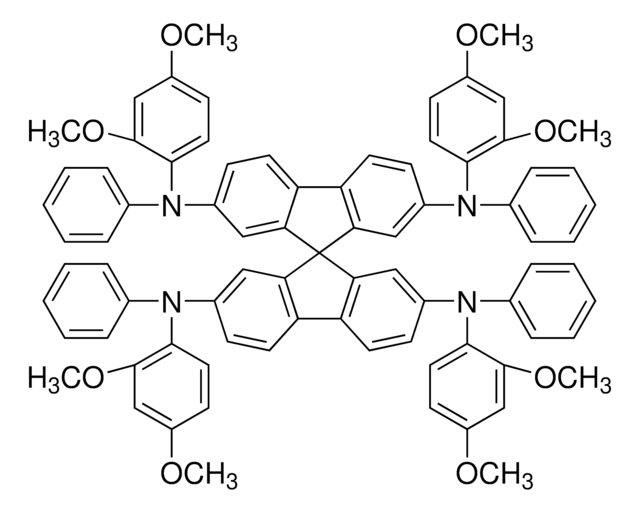792071
Spiro-MeOTAD
99% (HPLC)
Sinonimo/i:
N2,N2,N2′,N2′,N7,N7,N7′,N7′-ottakis(4-metossifenil)-9,9′-spirobi[9H-fluorene]-2,2′,7,7′-tetramina, Spiro-OMeTAD
About This Item
Prodotti consigliati
Saggio
99% (HPLC)
Forma fisica
solid
Caratteristiche più verdi
Design for Energy Efficiency
Learn more about the Principles of Green Chemistry.
sustainability
Greener Alternative Product
Punto di fusione
243-248 °C
λmax
306 nm in dichloromethane
385 nm in dichloromethane
Fluorescenza
λem 429 nm in dichloromethane
Categoria alternativa più verde
, Enabling
Stringa SMILE
COC(C=C1)=CC=C1N(C2=CC=C(C=C2)OC)C(C=C3)=CC4=C3C(C=CC(N(C5=CC=C(C=C5)OC)C6=CC=C(C=C6)OC)=C7)=C7C84C9=C(C=CC(N(C%10=CC=C(C=C%10)OC)C%11=CC=C(C=C%11)OC)=C9)C%12=C8C=C(N(C%13=CC=C(C=C%13)OC)C%14=CC=C(C=C%14)OC)C=C%12
InChI
1S/C81H68N4O8/c1-86-65-29-9-53(10-30-65)82(54-11-31-66(87-2)32-12-54)61-25-45-73-74-46-26-62(83(55-13-33-67(88-3)34-14-55)56-15-35-68(89-4)36-16-56)50-78(74)81(77(73)49-61)79-51-63(84(57-17-37-69(90-5)38-18-57)58-19-39-70(91-6)40-20-58)27-47-75(79)76-48-28-64(52-80(76)81)85(59-21-41-71(92-7)42-22-59)60-23-43-72(93-8)44-24-60/h9-52H,1-8H3
XDXWNHPWWKGTKO-UHFFFAOYSA-N
Descrizione generale
Applicazioni
Codice della classe di stoccaggio
11 - Combustible Solids
Classe di pericolosità dell'acqua (WGK)
WGK 3
Punto d’infiammabilità (°F)
Not applicable
Punto d’infiammabilità (°C)
Not applicable
Certificati d'analisi (COA)
Cerca il Certificati d'analisi (COA) digitando il numero di lotto/batch corrispondente. I numeri di lotto o di batch sono stampati sull'etichetta dei prodotti dopo la parola ‘Lotto’ o ‘Batch’.
Possiedi già questo prodotto?
I documenti relativi ai prodotti acquistati recentemente sono disponibili nell’Archivio dei documenti.
I clienti hanno visto anche
Articoli
Solar panel demand surges for sustainable energy, with power output rising from 5.0 to 90 GWh/d from 2010 to 2016.
Explore the eco-friendly potential of organic thin film transistors (OTFTs) for detecting chemical analytes, identifying viruses, and assisting in health diagnostics. This mini-review highlights challenges of achieving sustainability, safety, and biodegradability of each component of an OTFT sensor.
While dye sensitization as the basis for color photography has been accepted for a very long time,1 attempts to use this principle for the conversion of solar light to electricity generally had resulted only in very low photocurrents, below 100 nA/cm
Next generation solar cells have the potential to achieve conversion efficiencies beyond the Shockley-Queisser (S-Q) limit while also significantly lowering production costs.
Contenuto correlato
L’elettronica organica utilizza conduttori e semiconduttori organici per applicazioni nel settore del fotovoltaico organico, dei diodi organici a emissione luminosa e dei transistor organici a effetto di campo.
Organic electronics utilizes organic conductors and semiconductors for applications in organic photovoltaics, organic light-emitting diodes, and organic field-effect transistors.
Il team dei nostri ricercatori vanta grande esperienza in tutte le aree della ricerca quali Life Science, scienza dei materiali, sintesi chimica, cromatografia, discipline analitiche, ecc..
Contatta l'Assistenza Tecnica.









